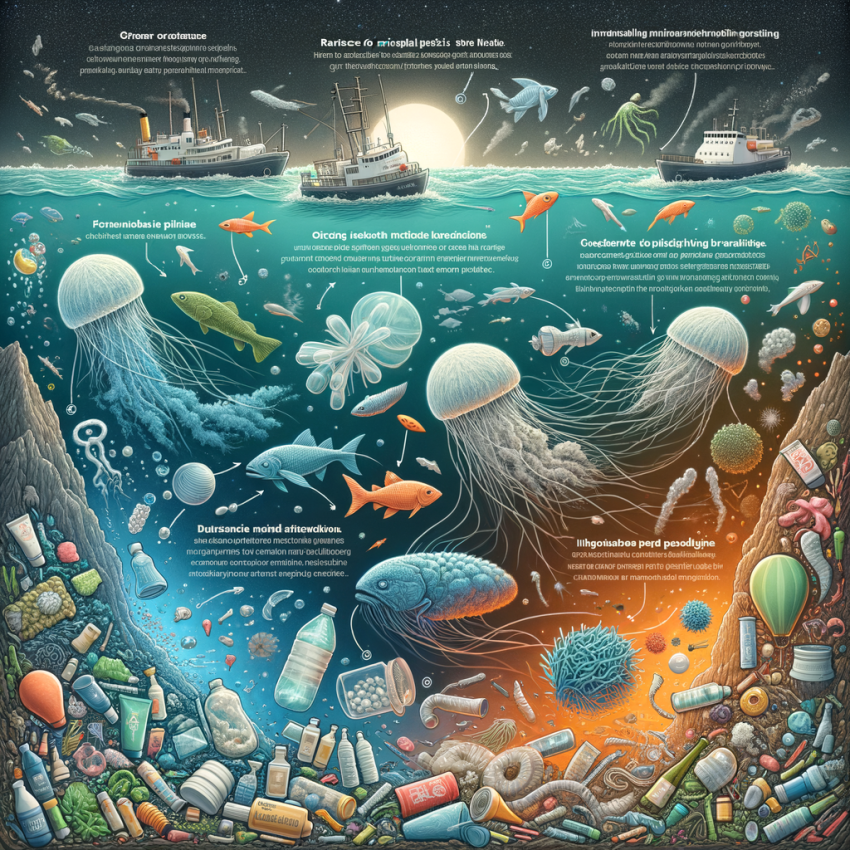The Impact of Microplastics on Marine Life
Ingestion and Blockage
Microplastics pose a significant threat to marine life as they can be ingested by a wide variety of organisms, ranging from small zooplankton to large marine mammals. When ingested, microplastics can accumulate in the digestive tracts of marine animals, causing blockages and disruptions to their digestive systems. This can lead to reduced nutrient absorption, decreased growth, and starvation. Furthermore, microplastics can adsorb and concentrate toxic chemicals from the surrounding water, which can be transferred up the food chain when ingested by predators.
Entanglement
Microplastics can also cause entanglement, particularly in marine species with filter-feeding mechanisms, such as baleen whales, sea turtles, and some fish species. These animals can become entangled in plastic debris, which can restrict their movement, cause injury, and even lead to death. Entanglement can hinder an animal’s ability to feed, reproduce, and escape from predators, significantly impacting their survival and overall population dynamics.
Habitat Degradation
Microplastics can also alter marine habitats by accumulating on shorelines, forming floating plastic debris patches, and settling on the seabed. These accumulations can disrupt natural ecosystems, smother benthic organisms, and alter sediment characteristics. Moreover, microplastics can adsorb and concentrate pollutants, which can be released into the marine environment over time, posing a persistent and long-term threat to marine life.
Conclusion
Microplastics pose a significant and growing threat to marine life, causing ingestion and blockage, entanglement, habitat degradation, and potential transfer of toxic chemicals up the food chain. It is crucial to take action to reduce microplastic pollution and protect the health and integrity of our marine ecosystems.
How to Reduce Microplastic Pollution in Your Daily Life
Reduce Your Use of Plastic Products
One of the most effective ways to reduce microplastic pollution is to simply use less plastic. This means avoiding single-use plastics like straws, utensils, and bags whenever possible. You can also choose products that are made from recycled or compostable materials instead of traditional plastics.
Choose Personal Care Products Without Microbeads
Microbeads are tiny plastic particles that are often added to personal care products like face wash, toothpaste, and body scrubs. These beads can easily wash down the drain and end up in our waterways, where they can harm marine life. When shopping for personal care products, be sure to choose products that are labeled “microbead-free.”
Dispose of Plastic Properly
It’s important to dispose of plastic properly to prevent it from becoming litter. This means recycling plastic whenever possible and throwing away plastic in a trash can instead of littering it. You can also help to reduce microplastic pollution by properly disposing of cigarette butts, which contain plastic filters.
Participate in Beach Cleanups
Beach cleanups are a great way to help remove microplastics from our oceans. When you participate in a beach cleanup, you’re helping to remove plastic debris from the sand and water, which prevents it from harming marine life. Beach cleanups are also a great way to educate yourself about the problem of microplastic pollution and how you can help to reduce it.
Latest Research Findings on the Effects of Microplastics on Human Health
Ingestion of Microplastics and Its Potential Health Risks
Recent studies have shed light on the potential health risks associated with the ingestion of microplastics. Microplastics have been detected in a range of food items, including seafood, salt, and drinking water. Once ingested, these tiny plastic particles can accumulate in the human body, potentially leading to adverse health effects. Studies have linked microplastic ingestion to inflammation, oxidative stress, and genotoxicity, all of which can contribute to the development of chronic diseases such as cancer and cardiovascular disease.
The Role of Microplastics in Endocrine Disruption
Another significant area of concern is the potential role of microplastics in endocrine disruption. Microplastics can absorb and release various chemical compounds, including additives and plasticizers, which can interfere with the normal functioning of the endocrine system. Endocrine disruption can have wide-ranging effects on human health, including reproductive disorders, developmental abnormalities, and metabolic disorders. Research is ongoing to investigate the specific mechanisms and implications of microplastic-induced endocrine disruption.
The Need for Further Research and Policy Action
The current understanding of the health effects of microplastics is still evolving, and further research is warranted to establish a comprehensive understanding of the risks and develop strategies for mitigation. Given the potential health implications, it is crucial that policymakers and stakeholders take proactive steps to reduce microplastic pollution and protect human health. This includes implementing policies and regulations to limit the production and release of microplastics, promoting the development of sustainable alternatives, and raising awareness among consumers and industries about the importance of reducing microplastic pollution.
Learn More:HERE!

